|
|
 |
| February 12, 2003 |
 |
Dr. Anthony Irving
University of Washington
MARTIAN METEORITE NWA 1460 FOUND IN MOROCCO
|
NWA 1460 |
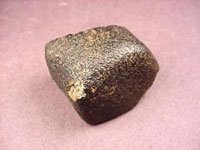
Image 1: Shergottite NWA 1460 complete
stone, showing fresh fusion crust and part of interior. Photo ©
Adam and Greg Hupe.
|
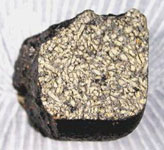
Image 2: Cut face of NWA 1460, showing
yellow pigeonite grains and dark maskelynite laths.
Photo © Nelson Oakes.
|
A 70.2 gram meteorite completely coated with fusion-crust found in
Morocco in December 2001 is almost certainly paired with basaltic
shergottite NWA 480
(acquired in November 2000 by Bruno Fectay and Carine Bidaut).
Small fragments from one end of the new stone were sent by a Moroccan
dealer to Adam and Greg Hupe, who submitted it for study by Drs.
Anthony Irving and Scott Kuehner at the University of Washington in
Seattle. The complete stone (referred to as "Black Beauty") was later
purchased by Pennsylvania collector Nelson Oakes. Like the smaller 28
gram NWA 480 stone, this new stone is very fresh and is coarser grained
than most other Martian meteorites. It consists mainly of large grains of
compositionally zoned, low-Ca pyroxene (with orthopyroxene cores,
augite mantles and pigeonite rims) and glassy, shocked plagioclase
(maskelynite), with lesser amounts of two phosphate minerals (merrillite
and chlorapatite), exsolved iron-titanium oxides, ilmenite, chromite,
pyrrhotite, potassium-rich glass, silica and baddeleyite. A distinctive
feature of both stones is the occurrence of complex intergrowths consisting
of varying amounts of fayalite+hedenbergite+silica along the boundaries
of pigeonite grains, which probably represent breakdown products
of former pyroxferroite (an iron-rich pyroxene-like mineral first found in
Apollo 11 lunar basalts). In addition, the University of Washington
scientists discovered crystals of baddeleyite (zirconium dioxide) associated
with the symplectites in NWA 1460. Baddeleyite was recently confirmed
by Dr. Albert Jambon in NWA 480 as well, and the patterns of
compositional zoning in the pyroxene grains of NWA 1460 match those
found by Barrat et al. (2002) for NWA 480. The almost identical
morphologies, textures and mineral compositions of both specimens
suggests strongly that they are paired stones from the same fall, and the
oxygen isotopic composition measured earlier for NWA 480 at the
University of Paris confirms its Martian origin. The new, larger stone now
will permit scientists to confirm the cosmic ray exposure age (2.4 million
years) measured by Marty et al. (2001) for NWA 480, and to measure
accurately the age of its igneous formation on Mars. The unusually fresh
fusion crust on both stones suggests that they are part of a relatively
recent fall (perhaps even within the last century) of an ancient volcanic
or shallow subsurface igneous rock ejected from Mars by a large impact.
There is a good possibility that other stones from the same fall also
landed in the western Sahara desert, but they may be difficult to find
because the exact locations of the two existing stones are known only
to the nomads who provided them to Moroccan dealers.
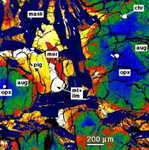
Image 3: False-color backscattered electron
image showing compositionally-zoned pyroxene grains (orthopyroxene
- blue; augite - green; pigeonite - red to yellow), maskelynite
(dark blue), merrillite (red), and titanomagnetite and chromite (white).
Photo © Anthony Irving and Scott Kuehner.
|
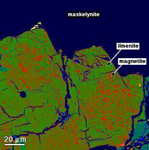
Image 4: False-color backscattered electron
image showing an exsolved iron-titanium oxide grain containing
oriented lamellae of ilmenite (green) within titanomagnetite (red).
Photo © Anthony Irving and Scott Kuehner.
|

Image 5: False-color backscattered electron
image showing a symplectitic intergrowth of fayalite+hedenbergite+silica
at a contact between pigeonite and K-Al-Si-rich glass. Photo ©
Anthony Irving and Scott Kuehner.
|

Image 6:
False-color backscattered electron image showing a symplectitic
intergrowth of fayalite+silica at a contact between pigeonite and
merrillite. Photo © Anthony Irving and Scott Kuehner.
|
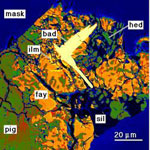
Image 7: False-color backscattered electron
image showing prismatic grains of baddeleyite (bright yellow)
associated with a fayalite+hedenbergite+silica symplectitic
intergrowth and ilmenite near a contact between pigeonite and
maskelynite. Photo © Anthony Irving and Scott Kuehner.
|
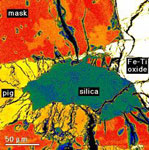
Image 8:
False-color backscattered electron image showing patchy
compositional zoning in maskelynite (top) and an interstitial grain of
silica (probably formerly shock-produced stishovite) containing
irregular dendritic structures and surrounded by radial cracks.
Photo © Anthony Irving and Scott Kuehner.
|
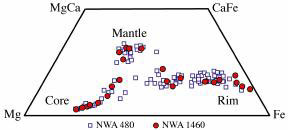
Image 9:
Plot of compositions of zoned pyroxene grains in NWA 480 and
NWA 1460. Diagram © Anthony Irving and Scott Kuehner.
|
View this pressrelease at the Mars Meteor Home Page.
###
|